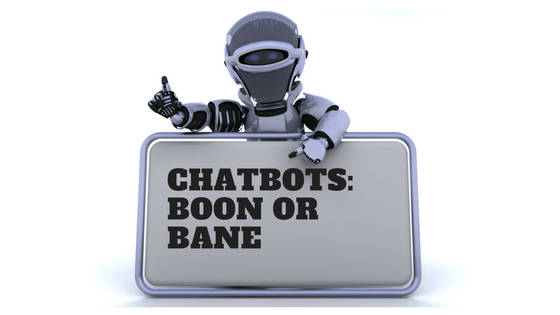Chatbots: Boon or Bane?

Machine learning is revolutionizing the current organizational structure by offering solutions to limited manpower capacity at reduced costs with better results. One such tool developed to enhance customer interaction which is becoming a part of our lives gradually is chatbots. These are technological machine-learned programs which are used to interact with the customer and improve the overall user experience on the website. While there are much talk going on chatbot advantages, we will discuss few disadvantages of chatbots also.
By using various human interactions as a source to learn, chatbots are partially prepared with everything that a beneficial conversation requires. However, there are still things that can make them lag behind from an actual human interaction.
Traditionally, there are two types of chatbots:
- AI-based: These chatbots thrive on dynamic learning and constantly update themselves using various customer interactions. They are intelligent, of superior design, and offer better user-experience.
- Fixed chatbots: These are programs with fixed information and hence offer limited help. They are used for segments with limited customer access or to resolve back-end queries. However, fixed chatbots are not-so-popular due to their inability to understand perplexed human behavior. Also, they may not be able to handle all the queries and hence come across as a challenge while interacting.
Chatbot Advantages:
Humans have a limit to the number of clients they can handle at once. However, with chatbots, there is no such constraint and they can handle as many queries as required at once.
- Reduced Costs – chatbots eliminate the requirement of any manpower during online interaction and are hence seen as a big advantage by companies receiving multiple queries at once. This also presents companies with the opportunity to save on costs while aligning chatbots with their goals and hence presenting customers with a particular type of interaction leading to conversion.
- 24-7 availability – Unlike humans, chatbots once installed can attend queries at any time of the day. Thus, the customer doesn’t have to wait for the company executive to help them. This also lets companies keep an eye on the traffic during the non-working hours and reach out to them later. On the other hand, while hiring people, there would be no access to these potential customers and could lead to loss of business.
- Learning and Updating – AI-based chatbots are capable of learning from interactions and updating themselves on their own. This is a big benefit when it comes to investing time in educating the executives about the same. Due to machine learning and algorithms capable of updating themselves, the need for same is eliminated while using a Chatbot.
- Multiple Customer Handling – Humans have a limit to the number of clients they can handle at once. However, with chatbots, there is no such constraint and they can handle as many queries as required at once. This is a major benefit of using chatbots as no customer stays unattended and everyone’s problem is being resolved. Developers are trying to come up with new features which can work on voice assisted services and help in guided sales. However, this is still expected to take some time, but will be a major breakthrough in the Chatbot and AI industry.
Chatbot Disadvantages:
- Complex Interface – Chatbots are often seen to be complicated and require a lot of time to understand user’s requirement. It is also the poor processing which is not able to filter results in time that can annoy people.
- Inability to Understand – Due to fixed programs, chatbots can be stuck if an unsaved query is presented in front of them. This can lead to customer dissatisfaction and result in loss. It is also the multiple messaging that can be taxing for users and deteriorate the overall experience on the website.
- Time-Consuming – Chatbots are installed with the motive to speed-up the response and improve customer interaction. However, due to limited data-availability and time required for self-updating, this process appears more time-taking and expensive. Therefore, in place of attending several customers at a time, chatbots appear confused about how to communicate with people.
- Increased Installation Cost – Chatbots are useful programs that help you save a lot of manpower by ensuring the all-time availability and serving to several clients at once. But unlike humans, every chatbot needs to be programmed differently for a new business which increases the initial installation cost. This also increases the time needed to prepare for the program and plan everything effectively. Considering the last-minute changes that can always happen, this is a risky investment as updating the program will invite added costs to it.
Zero decision-making – Chatbots are known for being infamous because of their inability to make decisions.
- Zero decision-making – Chatbots are known for being infamous because of their inability to make decisions. A similar situation has landed big companies like Microsoft etc. in trouble when their chatbot went on making a racist rant. Therefore, it is critical to ensure proper programing of your chatbot to prevent any such incident which can hamper your brand.
- Poor Memory – Chatbots are not able to memorize the past conversation which forces the user to type the same thing again & again. This can be cumbersome for the customer and annoy them because of the effort required. Thus, it is important to be careful while designing chatbots and make sure that the program is able to comprehend user queries and respond accordingly.
Thus, chatbots are a thing of the future which is yet to uncover its potential but with its rising popularity and craze among companies, they are bound to stay here for long. Machine learning has changed the way companies were communicating with their customers. With new platforms to build various types of chatbots being introduced, it is of great excitement to witness the growth of a new domain in technology while surpassing the previous threshold.
